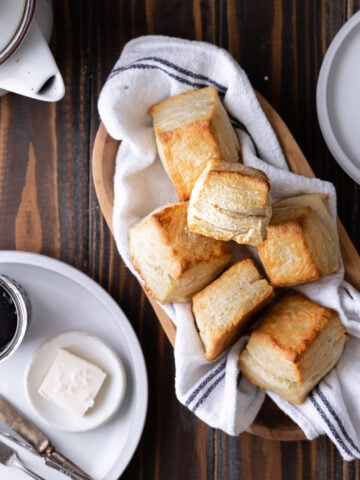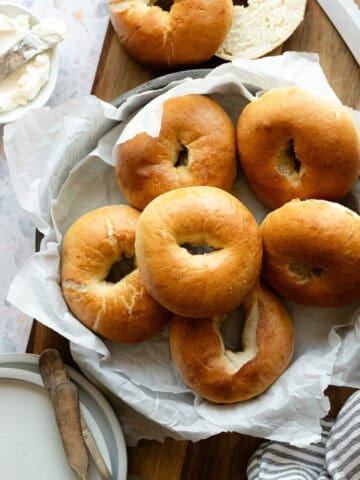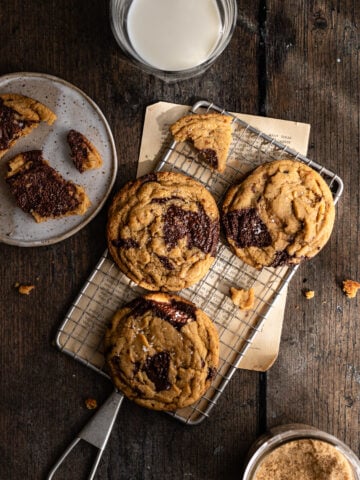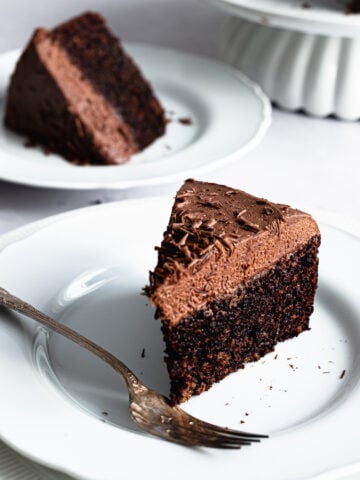Homemade Sourdough Cranberry Scones are soft, cakey with a bright orange flavor and a sweet and deliciously tangy cranberry filling. Top these beautiful rolled scones with an orange glaze for a delicious breakfast or afternoon snack.

Jump to:
Wow! There were quite possibly the best scones I’ve ever had! Really easy to make and my kids LOVED them. We’ll be making this an annual tradition for sure!
- Abby
Why I created this recipe
I’ve been seeing so many recipes for quick no yeast cinnamon rolls on social media so I thought I’d create my own take on the trend! These recipes are all basically a version of a quick bread (bread that’s leavened with baking powder or baking soda) that includes an egg. Which basically makes them scones.
Although I’ve added sourdough discard (which does contain yeast), I’m referring to these as “yeast-free” because I’m not using yeast as the leavener and the rolls don’t require a long rise time. The purpose of sourdough here is to add flavor and additional moisture.
What is a scone?
Scones are a type of quick bread that’s leavened with chemical leaveners like baking soda or baking powder instead of a biological leavener such as commercial yeast or sourdough starter. What differentiates scones from biscuits is the inclusion of an egg. This gives scones a cakier texture, as opposed to the flaky, layered crumb of a biscuit.

Baking with sourdough discard
Sourdough discard adds moisture and imparts a delicious tangy flavor to these scones. Since these are leavened with chemical leaveners, and you won’t be using your starter to make these sourdough scones rise, you can use your discard in this recipe straight from the fridge without activating or feeding it first.

What You Need
Sourdough discard - Both sourdough discard and active sourdough starter will work for this recipe! If you don't have a starter, simply add 56 grams all-purpose flour and 56 grams water to your dough.
All-purpose flour - Low protein content of all-purpose flour helps these bake up into tall scones with a tender crumb. Don't substitute whole wheat flour or your scones will turn out too gummy and dense.
Cranberries - Fresh or frozen cranberries work great for this recipe. I use this great ingredient in my recipe for Sourdough Cranberry Muffins.
Orange - Zest adds a refreshing citrus flavor to the scones, while a little bit of orange juice reacts with the baking powder to further tenderize these scones. Substitute lemon, lime or another citrus of your choice.
Cinnamon - Optional but highly recommended, adds a note of warmth to the filling.
Add-ins
When I first developed this recipe, I used fresh cranberries folded into my scone dough. While the scone was delicious, the cranberries were way too sour. On my second attempt, I decided to add sweetness by creating a homemade cranberry filling. The result was absolutely delicious, with the added bonus of being pretty!
I’ve included a recipe for cranberry preserves here, but feel free to use leftover cranberry sauce, homemade fruit preserves or even store-bought jam.
Prefer plain scones? Try my Sourdough Discard Scone recipe instead!
How to make sourdough rolled scones
These sourdough cranberry scones are straight forward, 2-bowl wet into dry ingredient process. You'll have delicious cranberry scones in less than 1 hour!
Step 1: Make the dough
Dissolve the sourdough starter in wet ingredients. Rub the butter into the flour. Create a well in the center of the flour and pour the starter mixture in. Lightly knead the dough until it comes together.

Avoid overworking your dough
Gentle kneading is the key to delicious, tender scones. Too much gluten development as a result of overworking your dough will make your scones tough and dry. Knead your dough just until the dough looks cohesive and all the flour is hydrated.
Step 2: Assemble and bake
Make the filling. Flatten the dough out into a 10 by 12 inch rectangle. Spread the cooled filling on top. Roll the dough into a tight log. Divide it into 8 even portions. Bake at 425 F for 10 minutes, turn the temperature down to 350 F and bake for another 10 minutes or until golden brown.

Baker's Tips
- Use leftover cranberry sauce or make your own Homemade Cranberry Jam.
- Both sourdough discard and active sourdough starter will work for this recipe.
- Weigh your ingredients. Measuring with a scale is much more accurate than using cups and tablespooons.
- Start baking these scones at a high temperature to encourage them to rise and turn down the temperature to prevent them from burning.
Make ahead instructions
Filling: You can make the filling up to 3 days in advance and store the cranberry filling in an airtight container in the refrigerator until ready to use.
Freezing Instructions: Assemble the scones, arrange in a single layer on a baking sheet. Freeze the dough uncovered for at least 2 hours. Transfer the frozen scones into an airtight container.
Baking frozen scones: Bake at 425 F for 10 minutes and 350 F for 15 to 18 minutes.
Recipe FAQs
Scones are a balancing act, gummy scones are usually the result of undermixed dough. Pockets of unmixed flour will have a detrimental effect on your scones, causing them to be crumbly, dense and gummy.
Your baking powder may have expired. A lot of bakers don’t know that chemical leaveners have a shelf life. Make sure yours is fresh before using it by mixing a little bit with a drop of vinegar. If it bubbles then it’s still good to use, if it stays flat then it’s no longer viable.
The short answer is no. The production of carbon dioxide is essential for light and tender baked goods. Baking powder produces CO2 by reacting with the liquids in the recipe to create a chemical reaction, while sourdough produces it through fermentation. For your dough to capture the gas produced through fermentation, you’ll need to strengthen the gluten in your dough. Gluten development is detrimental to tender baked goods like scones and biscuits. Our goal is a soft, short (not stretchy like bread) texture, so we use chemical leaveners like baking powder and baking soda for quick breads and cakes.
I prefer to make small batches of scones since they are best enjoyed the day they are baked, but will keep well in an airtight container for up to 2 days.
Did this recipe rise to the occasion?
★★★★★
Please leave a star rating and a comment. Your feedback helps me create more delicious sourdough recipes. I read and truly appreciate every message.
Don't forget to PIN this recipe on Pinterest to save it for later!
Thank you for your support!

Sourdough Cranberry Scones Recipe
Equipment
This section may contain affiliate links
Ingredients
Filling
- 150 grams cranberries
- 50 grams granulated sugar
- 1 teaspoon ground cinnamon optional
- 28 grams orange juice
Dough
- 75 grams milk
- 1 egg
- 113 grams sourdough discard
- 300 grams all-purpose flour plus more for dusting
- 12 grams baking powder
- 6 grams kosher salt
- 50 grams granulated sugar
- 84 grams unsalted butter cubed, preferably frozen
- Zest of one orange
- 14 grams fresh orange juice
Glaze
- 84 grams powdered sugar
- 14 to 28 grams orange juice
- 14 grams unsalted butter melted and cooled
Click US Customary to view volume measurements
Instructions
- Make the filling: Combine the cranberries, sugar, cinnamon and orange juice in a small saucepan, cook over medium heat until the cranberries have completely broken down and the mixture has thickened, about 10 minutes. Transfer the mixture to a heatproof bowl and let it cool completely before using.150 grams cranberries, 50 grams granulated sugar, 1 teaspoon ground cinnamon, 28 grams orange juice
- Prep: Preheat the oven to 425 F. Line a baking sheet with parchment paper.
- Mix the wet ingredients: Dissolve the sourdough discard and stir the egg into the milk until completely dissolved and no traces of discard or egg remain. Set aside.75 grams milk, 1 egg, 113 grams sourdough discard
- Mix the dry ingredients: Whisk together the flour, baking powder, salt and sugar in a large bowl.300 grams all-purpose flour, 12 grams baking powder, 6 grams kosher salt, 50 grams granulated sugar, Zest of one orange
- Cut the butter into the flour: Toss the cubes of butter in the flour. Use your fingertips to squeeze the cubes and your palms to rub the butter into the flour until you end up with coarse crumbs of varying sizes.84 grams unsalted butter
- Make the dough: Make a well in the center of the flour, pour half of the liquid into the center of the well. Use a fork or wooden spoon to gently mix the ingredients together. Bring the dough together and drizzle the remaining liquid on any portions of flour that are not hydrated.
- Knead: Turn the dough out on a clean, lightly floured work surface and knead the dough lightly just until the dough feels cohesive and no patches of dry flour remain.
- Shape: Dust more flour on the work surface. Using a rolling pin, flatten the dough out to a 10 by 12 inch rectangle. Spread an even layer of the filling over the dough, leaving a ½-inch border. Working with the longer side, roll the dough into a tight log. Using a sharp knife, divide the dough into 8 even portions. Position the dough on the prepared baking sheet about 2 inches apart to allow them to rise and spread.
- Bake: Bake scones for 10 minutes at 425 F (220 C) and then reduce oven temperature to 350 F (160 C) for another 10 minutes. Don’t over bake or your scones will turn out too tough and crusty.
- Make the glaze: Combine the 1 tablespoon orange juice, butter and powdered sugar in a small bowl. Whisk together until no lumps remain, add the remaining orange juice little by little until you achieve your desired consistency.14 grams fresh orange juice, 84 grams powdered sugar, 14 to 28 grams orange juice, 14 grams unsalted butter
- Enjoy: Take scones out of the oven and place on a wire rack to cool. Drizzle glaze over the scones and enjoy!
- Store: These are best eaten on the day they are baked, but will keep well stored in an airtight container for 2 days at room temperature.
Tips
These recipes were developed and tested using grams for precise measurements. To increase your chances of success, I recommend investing in a kitchen scale. I've included rough volume estimates (in tablespoons and cups), but they might not be totally accurate.
Remember all ovens are unique, these recipes were tested in my oven which runs cooler than others. You might need to lower the temperature if your bake appears to be browning too quickly. Monitor your bake closely and make adjustments if needed.
Notes
Nutrition
I am not a nutritionist or dietitian, any nutrition information provided is an estimate.









Patricia says
I've not had good experiences making scones, even though I'm intentionally trying to use a light hand while mixing dough; the crumb texture is usually too heavy. Can you please provide particular details about how to not overwork the dough? Thank you, Hannah!
Hannah Dela Cruz says
Try turning the dough out onto a piece of plastic wrap and bringing the dough together that way. This will prevent the dough getting too warm and the butter from melting. This might help!
Patricia says
These look fabulous and I'm excited to make this recipe! Please clarify "discard" sourdough, specifically the period of time from its last feeding?
Thank you, Hannah!
Hannah Dela Cruz says
There's no exact time - any portion of sourdough starter you don't use for making bread is considered discard.
Callie says
I’m sorry if I missed it, but at which stage does the zest go in?
Hannah Dela Cruz says
The zest can go in with the rest of the dry ingredients!
Ari says
My friend said he would eat scones more often if they all tasted like this! Straightforward recipe and instructions. I added orange zest to the glaze too.
Abby says
Wow! There were quite possibly the best scones I’ve ever had! Really easy to make and my kids LOVED them. We’ll be making this an annual tradition for sure!